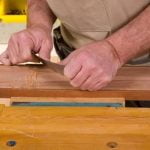Woodworking tools are essential for anyone who enjoys working with wood, but they can quickly become coated in sap, which can be a challenge to remove. In this article, we will explore the importance of cleaning sap off woodworking tools and provide valuable tips and techniques to help you do so effectively.
When left uncleaned, sap can accumulate on your tools, making them sticky and less efficient. It can also cause wood to stick to the blades or bits, resulting in uneven cuts and potentially damaging your materials. Regularly removing sap from your woodworking tools not only ensures their longevity but also enhances their performance.
Understanding the different types of sap is crucial in determining the best cleaning methods. Resinous sap is thicker and stickier compared to non-resinous sap, requiring more intensive cleaning techniques. By identifying the type of sap on your tools, you’ll be able to choose the appropriate cleaning supplies and methods for effective removal.
Properly preparing your tools before cleaning is essential to ensure that you have everything you need at hand. Gather the necessary cleaning supplies such as a degreaser or solvent, scrubbing brushes or pads, old rags or towels, and protective gloves. Having these items readily available will streamline the cleaning process and prevent any delays or interruptions.
In the following sections of this article, we will provide step-by-step instructions on how to clean sap off woodworking tools effectively. Additionally, we will share tips for safely removing sap without damaging your tools and explore alternative cleaning solutions for stubborn stains. Furthermore, we will cover proper care and maintenance practices to prevent future sap build-up and discuss preventive measures for minimizing accumulation on woodworking tools.
Regularly cleaning and maintaining your woodworking tools are vital not only for their optimal performance but also for ensuring their longevity. The next section will delve into understanding the different types of sap found on woodworking tools – resinous versus non-resinous sap – so that you may choose appropriate methods for its effective removal.
Understanding the Types of Sap
When it comes to cleaning sap off woodworking tools, it’s important to understand the types of sap you may encounter. Two main categories of sap are resinous and non-resinous sap. Differentiating between these two types is crucial as they require different cleaning methods.
Resinous Sap
Resinous sap is commonly found in coniferous trees such as pine, spruce, and fir. It is thick, sticky, and can harden over time. Resinous sap tends to be more difficult to remove compared to non-resinous sap. If not properly cleaned, it can build up on woodworking tools and cause them to become less effective.
To clean resinous sap off your woodworking tools, start by using a solvent or cleaner that is safe for wood surfaces. Mineral spirits or rubbing alcohol are effective options. Apply a small amount of the chosen solvent onto a cloth or sponge and gently rub the affected areas until the sap begins to dissolve. Once the residue has loosened, wipe it away with a clean cloth.
Non-Resinous Sap
Non-resinous sap, also known as tree gum or pitch, is often found in hardwood trees like maple or oak. This type of sap is typically softer and easier to remove than resinous sap. However, if left untreated, it can still harden and create difficulties when using woodworking tools.
To remove non-resinous sap from your woodworking tools, start by scraping off any visible hardened bits with a plastic scraper or old credit card. Then, dampen a cloth with warm water and mild soap. Gently rub the affected areas until the sap dissolves and wipes away easily. Avoid using harsh chemicals or solvents on wood surfaces as they may damage the finish.
Understanding the difference between resinous and non-resinous sap will help you choose the appropriate cleaning method for your woodworking tools. By employing the right techniques, you can effectively remove sap without causing any damage to your valuable equipment.
Preparing Your Tools
Before you begin the process of cleaning sap off your woodworking tools, it is important to gather all the necessary cleaning supplies. Having these items on hand will ensure that you are well-prepared to effectively remove the sap without causing damage to your tools. Here is a list of essential cleaning supplies:
- Safety gloves: Protect your hands from any chemicals or sharp edges while cleaning. Choose gloves that are durable and resistant to chemicals.
- Protective eyewear: Safeguard your eyes from any splashes or debris during the cleaning process. Make sure your eyewear provides adequate protection and fits securely.
- Soft cloths: Use soft, lint-free cloths for wiping away sap and other residues from your tools. Avoid using rough or abrasive materials that could scratch or damage the surface.
- Isopropyl alcohol: An effective solvent for removing sap stains, isopropyl alcohol can easily dissolve sticky residues and evaporates quickly without leaving behind any residue.
- Citrus-based cleaner: Citrus-based cleaners, such as orange oil or lemon oil, are natural solvents that can break down sticky substances like sap. They also leave a pleasant scent behind.
- Fine-grit sandpaper: If there are stubborn sap stains on your woodworking tools, fine-grit sandpaper can be used to carefully remove them without damaging the tool’s surface.
- Mineral spirits or turpentine: These solvents are useful for dissolving hardened resinous sap on tools like saw blades or router bits. However, use caution when handling these substances and ensure proper ventilation in your workspace.
- Bucket or container filled with warm soapy water: This will be used for general cleaning and soaking of smaller woodworking tools such as chisels, planes, and carving knives directly after use to prevent sap from hardening.
Having all these supplies readily available will make the process of cleaning sap off your woodworking tools much easier and more efficient. By using the right cleaning materials, you can ensure that your tools are thoroughly cleaned without causing any damage or staining. Remember to always follow safety precautions when handling chemicals and wear protective gear as necessary.
Removal Techniques
Gather Your Supplies
Before you begin the process of removing sap from your woodworking tools, it’s essential to gather all the necessary supplies. Here are some items you will need:
- Goo Gone or a similar adhesive remover: This product is effective in breaking down the sticky sap residue on your tools.
- Soft cloth or sponge: Choose a non-abrasive cloth or sponge to avoid scratching your tools during the cleaning process.
- Isopropyl alcohol: This can be used as an alternative to Goo Gone and works well in dissolving sap.
- Steel wool or fine-grit sandpaper: These abrasive materials can help remove stubborn sap stains, but be cautious not to damage the tool’s surface.
- Safety gloves and goggles: It’s important to protect yourself while handling chemicals or using abrasive substances.
Step-by-Step Guide
- Begin by wearing safety gloves and goggles for protection.
- Apply a small amount of Goo Gone or adhesive remover onto a soft cloth or sponge and apply it directly to the sap-covered area of your tool, ensuring it is fully saturated.
- Gently rub the affected area with the cloth or sponge, using circular motions to loosen the sap from the surface of the tool.
- For more stubborn sap residues, use steel wool or fine-grit sandpaper to gently scrub off the remaining residue, taking care not to scratch the tool’s finish.
- If you prefer an alternative method, soak a clean cloth in isopropyl alcohol and place it directly on top of the sap stain for several minutes. Then, gently rub away any remaining residue with the cloth or sponge.
- Once all traces of sap have been removed, rinse off any remaining cleaning solution with water and dry your tools thoroughly before storing them away.
Remember that different types of wood may react differently to cleaning solutions, so it’s always a good idea to test the products on a small, inconspicuous area of your tool before applying them extensively.
By following these step-by-step instructions, you can effectively remove sap from your woodworking tools, ensuring they remain clean and well-maintained for future projects.
Tips for Effective Cleaning
Maintaining clean and sap-free woodworking tools is essential for their optimal performance and longevity. However, it’s important to clean off the sap without causing any damage to the tools. Here are some tips for effectively cleaning your woodworking tools while keeping them safe:
- Choose the Right Cleaning Solution: When removing sap from woodworking tools, it’s crucial to use a cleaning solution that is safe for both the tools and the user. Avoid using harsh chemicals or abrasive cleaners that can cause damage or corrosion. Opt for gentle solutions such as dish soap mixed with warm water or a specialized tool cleaner.
- Use Soft Brushes: To remove sap without scratching or damaging the tools’ surface, use soft brushes made of natural materials like horsehair or nylon bristles. These brushes will effectively lift off the sap while being gentle on the tool’s finish.
- Scrub Gently: While it may be tempting to vigorously scrub away at stubborn sap stains, this can lead to scratches or dents in the tool’s surface. Instead, apply gentle pressure and scrub in circular motions until the sap loosens and is removed.
- Soak Stubborn Sap Stains: If you encounter particularly stubborn sap stains that are difficult to remove, try soaking the affected area in a vinegar solution or rubbing alcohol. Place a cloth soaked in either of these solutions on top of the stain for a few minutes before gently scrubbing it away.
- Dry Thoroughly: After cleaning off any sap from your woodworking tools, make sure to dry them thoroughly before storing them away. This prevents moisture build-up and reduces the risk of rusting or other types of damage.
By following these tips, you can safely remove sap from your woodworking tools without compromising their quality or performance. Regular cleaning not only ensures that your tools stay in good condition but also enhances your overall woodworking experience by preventing sticky residues that can affect your workmanship.
Alternative Methods
When it comes to cleaning sap off woodworking tools, sometimes traditional cleaning methods may not be enough to remove stubborn sap stains. In such cases, it is worth exploring alternative cleaning solutions that can effectively tackle these persistent marks. Here are a few alternative methods that you can try:
- Vinegar Solution: Vinegar is known for its excellent cleaning properties and can be effective in removing sap stains from woodworking tools. To create a vinegar solution, mix equal parts of white vinegar and warm water in a bowl or container. Soak a clean cloth or sponge in the solution and gently scrub the affected areas on your tools. The acidity in the vinegar helps break down the sticky residue left by sap.
- Rubbing Alcohol: Rubbing alcohol is another handy household item that can aid in removing stubborn sap stains. Dampen a cloth or cotton ball with rubbing alcohol and gently rub it over the affected areas on your tools. The alcohol breaks down the sap, making it easier to remove. Be sure to test the rubbing alcohol on a small, inconspicuous area of your tool first to ensure it does not cause any damage or discoloration.
- Lemon Juice: Lemon juice contains natural acids that can help dissolve sap stains on woodworking tools. Squeeze fresh lemon juice onto a clean cloth or sponge and gently rub it over the affected areas. Allow the lemon juice to sit on the stain for a few minutes before wiping it away with a damp cloth. The acidic properties of lemon juice will work to break down and loosen the sap from the surface of your tools.
| Cleaning Solution | Ingredients | Effectiveness | Potential Side Effects |
|---|---|---|---|
| Vinegar Solution | Equal parts white vinegar and warm water | Effective in breaking down sap stains | Potential risk of corroding certain types of metal tools |
| Rubbing Alcohol | Rubbing alcohol | Effective in dissolving stubborn sap stains | Potential risk of damaging certain finishes or materials on tools |
| Lemon Juice | Fresh lemon juice | Effective in loosening and removing sap stains | Potential risk of bleaching or discoloring certain types of wood or finishes on tools |
Remember to always test these alternative cleaning solutions on a small, inconspicuous area of your woodworking tool before applying them to the entire surface. This will help you determine any potential side effects or damage that may occur. Additionally, it is important to exercise caution and follow safety guidelines when using these alternative methods.
By exploring alternative cleaning solutions, you can effectively remove stubborn sap stains from your woodworking tools and keep them in top condition for future use.
Maintaining Your Tools
Proper care and maintenance of woodworking tools are essential not only for their longevity but also for preventing the build-up of sap. Sap can be a stubborn substance that adheres to woodworking tools, making them difficult to use and potentially causing damage over time. By following a few simple steps, you can maintain your tools properly and prevent sap build-up.
One crucial aspect of maintaining your woodworking tools is regular cleaning. After each use, it is important to remove any debris, such as sawdust or wood shavings, from the tool surfaces. This step will help prevent sap from accumulating on the tools and ensure optimal performance during your next woodworking project. Additionally, wiping down the tools with a clean cloth dipped in mineral spirits or denatured alcohol can help dissolve any sap residue that may be present.
To prevent sap build-up on your woodworking tools, proper storage is essential. Tools should be stored in a dry environment away from extreme temperatures and humidity, as these conditions can promote the growth of sap on the surfaces. Consider investing in a toolbox or storage cabinet specifically designed for woodworking tools to protect them from dust, moisture, and potential contact with sap-producing materials.
Regular inspection of your tools is also vital in preventing sap build-up. Check for any signs of resinous sap deposits or sticky residue that may have accumulated over time. If you notice any traces of sap, promptly clean the affected areas using the appropriate cleaning techniques outlined in this article.
| Maintenance Step | Description |
|---|---|
| Regular Cleaning | Removing debris and wiping down tools with mineral spirits or denatured alcohol to dissolve sap residue. |
| Proper Storage | Storing tools in a dry environment, away from extreme temperatures and humidity, to prevent sap growth. |
| Regular Inspection | Checking for signs of sap build-up and promptly cleaning affected areas. |
Preventive Measures
While knowing how to effectively clean sap off woodworking tools is crucial, it is equally important to take preventive measures in order to minimize sap accumulation in the first place. By implementing a few simple tips and tricks, you can significantly reduce the amount of sap that builds up on your tools, making the cleaning process much easier and less frequent.
Firstly, one of the best preventive measures is utilizing a protective coating on your woodworking tools. Applying a thin layer of paste wax or mineral oil to the metal surfaces of your tools can help create a barrier between the wood and sap, making it harder for the sap to adhere in the first place. Be sure to wipe down your tools with a cloth after each use to remove any excess wax or oil.
Secondly, storing your woodworking tools properly can also prevent sap accumulation. After use, clean off any sawdust or debris from your tools and make sure they are completely dry before storing them away. Moisture can attract sap, so ensuring that your tools are clean and dry will help reduce the likelihood of sap build-up over time.
Furthermore, it is recommended to keep your woodworking tools covered when not in use. Whether using tool rolls, cases, or sheaths specifically designed for each tool, protecting them from exposure can go a long way in preventing sap accumulation. This will also protect your tools from other forms of damage such as rust or accidental knocks.
By following these preventive measures consistently, you will find that cleaning sap off woodworking tools becomes a less frequent task. Taking just a few extra minutes to implement these practices after each use will greatly extend the lifespan of your tools while also maintaining their optimal performance.
Common Mistakes to Avoid
When it comes to cleaning sap off woodworking tools, there are a few common mistakes that people often make. Avoiding these pitfalls can help ensure that your tools are not damaged and maintain their longevity.
One common mistake is using harsh chemicals or abrasive materials to clean the sap off the tools. This can cause damage to the surface of the tool, leading to scratches or even corrosion. It’s important to choose gentle cleaning solutions and materials that won’t harm the tool’s integrity.
For resinous sap, rubbing alcohol or mineral spirits can be effective in breaking down the sticky substance without causing damage. Non-resinous sap can often be removed with warm soapy water and a soft cloth.
Another mistake to avoid is leaving the sap on your tools for too long before attempting to clean it off. Sap can harden over time and become more difficult to remove.
It’s best to tackle the task as soon as you notice sap on your tools, minimizing the chances of it becoming stubbornly adhered. Regularly inspecting your tools and cleaning them thoroughly after each use will go a long way in preventing sap build-up and making the cleaning process easier.
Lastly, neglecting proper drying techniques after cleaning your tools can lead to additional issues. Moisture left on the tool’s surface can promote rust and corrosion, especially on metal parts. After rinsing or wiping away any cleaning solution used, make sure to thoroughly dry the tool before storing it away. Using a clean cloth and ensuring all areas are completely dry will help protect your tools from damage caused by moisture.
By avoiding these common mistakes, you can effectively clean sap off woodworking tools without risking damage or reducing their lifespan. Taking care of your tools during this process will ensure they remain in good condition for many years of use.
Conclusion
Regularly cleaning and maintaining woodworking tools is essential for their longevity and functionality. As we have learned throughout this article, sap build-up can heavily affect the performance of these tools and even cause irreversible damage if left unattended. Therefore, it is crucial to follow proper cleaning techniques and preventive measures to keep your tools in excellent condition.
By understanding the different types of sap and gathering the necessary cleaning supplies, you are already taking the first step towards effective tool maintenance. Following the step-by-step guide on how to clean sap off woodworking tools ensures that you remove the sticky resin without causing any harm. Additionally, incorporating alternative cleaning solutions for stubborn sap stains can provide some extra help when needed.
However, cleaning is only part of the equation. Proper care and maintenance should also be prioritized to prevent sap accumulation in the future. Regularly inspecting your tools for any signs of sap build-up and promptly addressing them can save you time, effort, and money in the long run. Implementing preventive measures such as applying a protective coating or using lubricants can also significantly minimize sap accumulation.
In conclusion, regularly cleaning and maintaining woodworking tools not only keeps them looking good but also ensures their optimal performance. With proper care, you can prolong the lifespan of your valuable tools and enhance your woodworking experience. By following the tips outlined in this article, you can say goodbye to sticky situations with sap and enjoy your woodworking projects hassle-free.
Frequently Asked Questions
What cleans tree sap off tools?
Tree sap can be a sticky and stubborn substance to remove from tools. However, there are a few effective ways to clean sap off tools. One common method is to use rubbing alcohol or isopropyl alcohol. Dampen a cloth or paper towel with the alcohol and gently rub the sap-covered areas of the tool until it starts to dissolve and come off.
Another option is to use mineral spirits or paint thinner. Apply a small amount onto a cloth and then rub it onto the sap, allowing it to break down the sticky residue. Afterward, clean the tool with soap and water to remove any residual traces of sap or cleaning agents.
What is the best way to remove tree sap from wood?
When it comes to removing tree sap from wood surfaces, it is important to be cautious as some methods may damage or stain the wood. One effective way is using a mild solvent such as rubbing alcohol or nail polish remover that contains acetone. Dampen a soft cloth with either of these substances and gently dab at the sap on the wood surface without vigorously scrubbing.
The solvent helps dissolve the sap without causing significant harm to the finish of the wood. Afterward, wipe away any residue with warm soapy water and ensure thorough drying.
What dissolves wood sap?
Wood sap can sometimes be dissolved using household substances readily available in most kitchens – such as vinegar or lemon juice. Both possess acidic properties that aid in breaking down and dissolving adhesive substances like sap on wood surfaces. To use this method, apply either vinegar or lemon juice directly onto a cloth or sponge and gently dab at the affected area, ensuring you do not excessively saturate or soak the wood surface.
Letting it sit for a few minutes will help weaken the adhesive properties of the sap before wiping away with warm water, followed by thorough drying. It’s important to note that depending on factors such as type of wood, finish, or varnish, different solvents may have varying effects; therefore, it is always recommended to test a small inconspicuous area before applying the solution extensively.

Hi everyone! I’m a woodworker and blogger, and this is my woodworking blog. In my blog, I share tips and tricks for woodworkers of all skill levels, as well as project ideas that you can try yourself.





